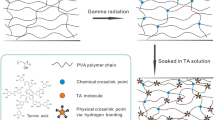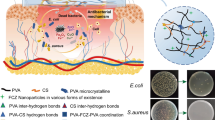Abstract
The development of easy and cost-effective strategies for making multifunctional hydrogels is of great scientific interest. Here, a chitosan/polyvinyl alcohol/tannic acid (CS/PVA/TA) composite hydrogel was prepared by a simple method of γ-ray-induced crosslinking and immersion in TA solution. The chemical composition, transparency, microstructure, mechanical properties and antibacterial activity of the obtained composite hydrogel were characterized by Fourier transform infrared spectroscopy (FTIR), ultraviolet–visible spectroscopy, scanning electron microscopy (SEM), tensile measurement, and antibacterial test, respectively. The immersion in TA not only provided a CS (Mw 20,000 g.mol−1)/PVA composite hydrogel with improved mechanical performance, i.e., tensile strength and elongation-at-break increased by 1100 and 487%, respectively, but also it preserved high transparency of the pure irradiated PVA hydrogel (transmittance exceeded 50% at 660 nm). In addition, the composite hydrogel possessed good antibacterial activity against gram-negative and gram-positive bacteria. The rationality of the immersion TA method in principle was proved by the hydrogen bond simulation. This work provides a simple method for the preparation of multifunctional hydrogels, suitable for large-scale production, and is expected to promote their application in the fields of biomedicine and wound dressings.
Graphic abstract









Similar content being viewed by others
References
Glass S, Kühnert M, Abel B, Schulze A (2019) Controlled electron-beam synthesis of transparent hydrogels for drug delivery applications. Polymers 11:501
Senol S, Akyol E (2018) Synthesis and characterization of hydrogels based on poly(2-hydroxyethyl methacrylate) for drug delivery under UV irradiation. J Mater Sci 53:14953–14963
Kong WQ, Gao CD, Hu SF, Ren JL, Zhao LH, Sun RC (2017) Xylan-modified-based hydrogels with temperature/pH dual sensitivity and controllable drug delivery behavior. Materials 10:304
Jiang S, Liu S, Feng W (2011) PVA hydrogel properties for biomedical application. J Mech Behav Biomed Mater 4:1228–1233
Zhang C, Liang KL, Zhou D, Yang HJ, Liu X, Yin XZ, Xu WL, Zhou YS, Xiao P (2018) High-performance photopolymerized poly(vinyl alcohol)/silica nanocomposite hydrogels with enhanced cell adhesion. ACS Appl Mater Int 10:27692–27700
Hong KH (2017) Polyvinyl alcohol/tannic acid hydrogel prepared by a freeze-thawing process for wound dressing applications. Polym Bull 74:2861–2872
Mansur HS, Sadahira CM, Souza AN, Mansur AAP (2009) FTIR spectroscopy characterization of poly (vinyl alcohol) hydrogel with different hydrolysis degree and chemically crosslinked with glutaraldehyde. Mater Sci Eng C 28:539–548
Nguyen TH, Ventura R, Min YK, Lee BT (2016) Genipin cross-linked polyvinyl alcohol-gelatin hydrogel for bone regeneration. J Biomed Sci Eng 9:419–429
Wang HH, Shyr TW, Hu MS (1999) The elastic property of polyvinyl alcohol gel with boric acid as a crosslinking agent. J Appl Polym Sci 74:3046–3052
Gough JE, Scotchford CA, Downes S (2002) Cytotoxicity of glutaraldehyde crosslinked collagen/poly(vinyl alcohol) films is by the mechanism of apoptosis. J Biomed Mater Res 61:121–130
Peppas NA, Stauffer SR (1991) Reinforced uncrosslinked poly (vinyl alcohol) gels produced by cyclic freezing-thawing processes: a short review. J Control Release 16:305–310
Mori Y, Tokura H, Yoshikawa M (1997) Properties of hydrogels synthesized by freezing and thawing aqueous polyvinyl alcohol solutions and their applications. J Mater Sci 32:491–496
Bhowmick S, Mohanty S, Koul V (2016) Fabrication of transparent quaternized PVA/silver nanocomposite hydrogel and its evaluation as an antimicrobial patch for wound care systems. J Mater Sci Mater Med 27:160
Rosiak JM, Ulański P (1999) Synthesis of hydrogels by irradiation of polymers in aqueous solution. Radiat Phys Chem 55:139–151
Chen WX, Bao HY, Zhang MW (1985) Effect of gamma radiation on gelation in polyvinyl alcohol solutions. Radiat Phys Chem 26:43–47
Ajjia Z, Othmana I, Rosiakb JM (2002) Production of hydrogel wound dressings using gamma radiation. Nucl Instrum Meth B 229:375–380
Salmawi KME (2007) Gamma radiation-induced crosslinked PVA/chitosan blends for wound dressing. J Macromol Sci A 44:541–545
Jeong JO, Park JS, Kim YA, Yang SJ, Jeong SI, Lee JY, Lim YM (2020) Gamma ray-induced polymerization and cross-linking for optimization of PPy/PVP hydrogel as biomaterial. Polymers 12:111
Ishak WHW, Ahmad I, Ramli S, Amin MCIM (2018) Gamma irradiation-assisted synthesis of cellulose nanocrystal-reinforced gelatin hydrogels. Nanomaterials 8:749
Orlowski P, Krzyzowska M, Zdanowski R, Winnicka A, Nowakowska J, Stankiewicz W, Tomaszewska E, Celichowski G, Grobelny J (2013) Assessment of in vitro cellular responses of monocytes and keratinocytes to tannic acid modified silver nanoparticles. Toxicol In Vitro 27:1798–1808
Kaczmarek B (2020) Tannic acid with antiviral and antibacterial activity as a promising component of biomaterials: a minireview. Materials 13:3224
Shutava T, Prouty M, Kommireddy D, Lvov Y (2005) pH responsive decomposable layer-by-layer nanofilms and capsules on the basis of tannic acid. Macromolecules 38:2850–2858
Erel-Unal I, Sukhishvili SA (2008) Hydrogen-bonded multilayers of a neutral polymer and a polyphenol. Macromolecules 41:3962–3970
Ge WJ, Cao S, Shen F, Wang YY, Ren JL, Wang XH (2019) Rapid self-healing, stretchable, moldable, antioxidant and antibacterial tannic acid-cellulose nanofibril composite hydrogels. Carbohyd Polym 224:115147
Chen YN, Jiao C, Zhao Y, Zhang J, Wang H (2018) Self-assembled polyvinyl alcohol-tannic acid hydrogels with diverse microstructures and good mechanical properties. ACS Omega 3:11788–11795
Fan LH, Yang H, Yang J, Peng M, Hu J (2016) Preparation and characterization of chitosan/gelatin/PVA hydrogel for wound dressing. Carbohyd Polym 146:427–434
Kadlubowski S, Grobelny J, Olejniczak W, Cichomski M, Ulanski P (2003) Pulses of fast electrons as a tool to synthesize poly(acrylic acid) nanogels: intramolecular cross-linking of linear polymer chains in additive-free aqueous solution. Macromolecules 36:2484–2492
Varshney L (2007) Role of natural polysaccharides in radiation formation of PVA-hydrogel wound dressing. Nucl Instrum Meth B 255:343–349
Fan HL, Wang L, Feng XD, Bu YZ, Wu DC, Jin ZX (2017) Supramolecular hydrogel formation based on tannic acid. Macromolecules 50:666–676
Lawrie G, Keen I, Drew B, Chandler-Temple A, Rintoul L, Fredericks P (2007) Interactions between alginate and chitosan biopolymers characterized using FTIR and XPS. Biomacromol 8:2533–2541
Li PP, Sirviö JA, Haapala A, Khakalo A, Liimatainen H (2019) Anti-oxidative and UV-absorbing biohybrid film of cellulose nanofibrils and tannin extract. Food Hydrocoll 92:208–217
Ninan N, Forget A, Shastri VP, Voelcker NH, Blencowe A (2016) Antibacterial and anti-inflammatory pH-responsive tannic acid-carboxylated agarose composite hydrogels for wound healing. ACS Appl Mater Inter 8:28511–28521
Zhang Y, Yang JC, Yu YX, Li YG (2005) Structural and hydrogen bond analysis for supercritical ethanol: a molecular simulation study. J Supercrit Fluids 36:145–153
He Y, Zhu B, Inoue Y (2004) Hydrogen bonds in polymer blends. Prog Polym Sci 29:1021–1051
Acknowledgements
We thank Yun Wang for the help of the antibacterial measurement.
Funding
Leading Talents Fund in Science and Technology Innovation in Henan Province (194200510030); Scientific Research and Development Project of Henan Academy of Sciences (190704002); Outstanding Youth Talent Training Project of Henan Academy of Sciences (200404008); Fundamental scientific research fees of Henan Academy of Sciences (200604056).
Author information
Authors and Affiliations
Contributions
Conceptualization, WG and MY; methodology, MY, WG, SL, XZ, and YC; writing—original draft preparation, WG, MY, XZ, and BZ; writing—review and editing WG, MY, and BZ; Project administration, MY. We confirmed that the order of authors listed in the manuscript has been approved by all named authors. All authors have read and agreed to the published version of the manuscript.
Corresponding author
Ethics declarations
Conflict of interest
There are no conflicts to declare.
Rights and permissions
About this article
Cite this article
Guo, W., Yang, M., Liu, S. et al. Chitosan/polyvinyl alcohol/tannic acid multiple network composite hydrogel: preparation and characterization. Iran Polym J 30, 1159–1168 (2021). https://doi.org/10.1007/s13726-021-00966-1
Received:
Accepted:
Published:
Issue Date:
DOI: https://doi.org/10.1007/s13726-021-00966-1




